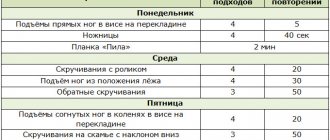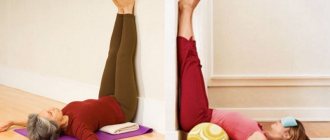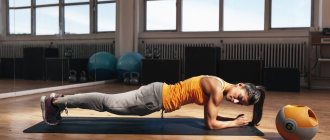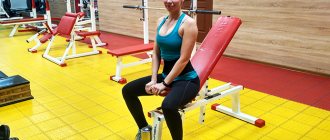If your typical day looks like this: wake up, house chores, work, run errands or take care of the kids, work, house chores, some more work, and finally sleep, then you, like me, have a very hard time finding time to an hour-long workout recommended by trainers. Have you ever encountered sets of exercises lasting 10 or 20 minutes? Beauty, isn't it? Just 10 minutes a day for weight loss and health! But is this real? How effective are 10 minute workouts?
Scientists from the US Centers for Disease Control and Prevention say adults should get 150 minutes of moderate-intensity exercise or 75 minutes of vigorous-intensity exercise per week.
Are 10-minute workouts effective?
If you divide 75 minutes by 7 days a week, you get 10 minutes a day. The first quick set of exercises was published in the magazine "Health and Fitness" of the American University of Sports Medicine.
High-intensity interval exercises, during which a person works for 20-30 seconds and rests for 10-15 seconds, takes only 10 minutes, and is comparable in effectiveness to 40-60 minutes of work in the gym. Such complexes, due to their high intensity, allow you to burn calories long after the end of your workout, which is especially useful for losing weight. You may have heard of Tabata protocols. A Tabata workout lasts 10-15 minutes. And it's very effective.
The scientific project “Social Science Library” studied the effect of fast interval training on the human body. They found that after 12 weeks of such training , cardiometabolic parameters were improved to the same extent as conventional endurance training, but took much less time per day.
The benefits of morning exercises
Morning exercise for 10 minutes is the minimum of your time, and the maximum benefit for well-being and activity. If you haven't done exercises before, it will be difficult for you to get into the mood for it at first. In order to develop a correct and useful habit, twenty-one days are enough for us, and the body itself will require a morning warm-up. The benefits of light exercise in the morning are as follows:
- Cheerfulness and energy . Even with minimal physical impact on the body, it wakes up much faster, blood circulation improves, and the body is actively saturated with oxygen. At the same time, you will receive maximum energy, which will ensure good health and excellent performance. Just ten minutes of charging will be a great start to an active and productive day.
- Good mood and positivity . Morning exercises do not involve intense exercise that will make you tired. This is just a light workout to warm up your muscles and work out your joints. In the process of doing this, the body produces joy hormones, endorphins, which help improve your mood and recharge yourself with positivity for the whole day ahead.
- Improved physical fitness . Exercising in the morning launches metabolism and enhances it, which promotes active fat burning and weight loss. As a result, the muscles become stronger, the body tightens, and becomes slimmer. And all this in ten minutes a day.
- Strength of will. How I want to soak in bed for at least a few more minutes! But to charge you need to get up 10 minutes earlier than usual. By developing this habit, you will improve your willpower and learn to overcome yourself, and then physical activity will become even more enjoyable.
- Strengthening the immune system . Morning exercises help strengthen the body's protective function and give it the opportunity to resist a number of diseases. As a result, the body is saturated with oxygen, all its organs are fully supplied with blood. All this improves not only physical, but also mental activity, in particular, concentration and concentration.
- Fighting insomnia. Morning exercise for 10 minutes is the best way to normalize your daily routine, which is the key to proper and complete sleep.
What about glycogen?
For those in ketosis, high glycogen stores are a thing of the past. We quickly switch to burning our own fats during training. For those not on the keto diet, let's remember what happens when you eat.
When food enters the body, it is broken down into simple sugars such as glucose. Insulin is released and glucose is transported to the cells of the body to supply them with energy. Excess glucose is stored as glycogen in the liver and muscles. And the residues are transformed into triglycerides and stored in fat depots.
High-intensity training will partially deplete your glycogen stores. Further influence, i.e. high calorie intake for recovery will use up these reserves. Therefore, the next time you eat, the entire cycle described above will occur. If through training you had not depleted (or partially depleted) the glycogen stores in the body, then the next meal would send glucose to the cells of the organs and to fats, since the glycogen stores are full.
Exercise No. 2
Lie on your back. Place your arms along your body with your palms on the floor. Raise your head and press your chin to your chest.
Photo source: youtube.com (ECONET.RU channel)
Raise your legs, trying to pull them towards your head. Return to the starting position slowly.
Photo source: youtube.com (ECONET.RU channel)
Initially, you need to perform 3-5 leg lifts, gradually increasing the load to 21 leg lifts.
Important! People who are overweight or have undergone surgery (for example, appendectomy) need to take special care when performing these exercises.
How should you exercise 10 minutes a day?
Intense 10-minute workouts improve blood flow, release adrenaline, speed up metabolism, burn calories, reduce stress, prolong life, improve brain function, and make us more energetic. One minute of intense running at 20-second intervals per day, three times a week, for 12 weeks showed improvements in metabolic and cardiovascular parameters in men.
Scientists from McMaster University in Hamilton, Ontario, found that even a few minutes of exercise at an intensity close to the body's maximum capacity produces changes at the molecular level comparable to those after several hours of running or cycling.
A little math.
In 10 minutes of intense work you will burn 150 kcal (+/- depending on your body weight and how much you push yourself). In 20 minutes you will burn 300 kcal. Personally, I train for 20 minutes. If you exercise every day for 10 minutes, you will burn 1000 kcal in addition to your diet, which is 100 grams of fat. If you exercise daily for 20 minutes, you will burn 2100 kcal, which is 200 grams of fat.
In 1 hour of training in the gym you will burn 500 kcal. But not everyone can train for 1 hour every day. Not everyone is a bodybuilder and not everyone needs it. Such training is often hazardous to health and involves great risks. Bodybuilders know why they do it. I don't think mere mortals need this. So, you train 3-4 times a week for 1 hour. In 1 hour of training you can burn 400-500 kcal. This is 1600-2000 kcal per week. This is 200 grams of fat.
So, 10-minute workouts should be:
- high intensity;
- include aerobic and strength exercises;
- use all major muscle groups;
- be interval, i.e. alternate high load and rest;
Fitness at home: training set of exercises for 10 minutes a day (PHOTO)
Don't have time for fitness? Famous case! Even if you have an annual card to a fitness club in your hands - and someone has a very expensive card to a fitness club - it’s impossible to go there to work out.
I propose to solve the problem this way: find at least ten minutes for fitness. I will show you one of thousands of options for a short, effective workout, which does not require a special room, no fancy equipment, or a lot of time. And I’m telling you for sure: ten minutes of fitness a day, week, month or even a year is better than decades of complete inactivity.
Get to know the exercises and then use my outline to create a workout that suits you.
Muscle stretching
Neck
Stand straight with your feet shoulder-width apart. Tilt your head towards your right shoulder and use your right palm to slowly and smoothly press on top of your head, stretching the neck muscles. Don't pull your shoulders toward your ears; focus on moving your ear toward your shoulder, and not vice versa.
Chest and shoulder girdle
Standing straight, raise your arms up and out to the sides, bending them, lowering your elbows to just above your shoulders. In this position, move your arms back slightly, opening your chest.
Back
Stretch your arms in front of you and clasp your hands together. Round your upper back as if pushing your shoulder blades back. Pull your stomach in, push your pelvis forward and slightly bend your knees.
Posterior thigh
Stand up straight and take a small step forward. Turn your back foot to the side about 30-45 degrees and bend your knee. As you exhale, tilt your body forward without rounding your back and keeping your abdominal muscles toned. You should feel a stretch in the back of your front leg.
Anterior thigh
Standing on one leg, bend the other at the knee and, grabbing your foot with your hand, smoothly pull it towards your buttock. Keep your knees together, push your pelvis slightly forward, and move your bent leg back.
Squats
Classic
Place your feet shoulder-width apart or slightly narrower. As you inhale, lower yourself down, bending your legs to a right angle at the knees. Don't confuse this with the thighs-parallel-to-the-floor position—it's not the same thing. The feet should be on the floor, move the pelvis back, shift the body weight slightly onto the heels. Lean your body forward slightly to avoid falling. As you exhale, straighten your legs and body, but do not straighten your knees all the way.
Difficulty level - 1.
[new-page]
With knee lift
Lower yourself down like a classic squat. As you rise, bend your leg at the top and lift your knee to the level of your hip joint. The supporting leg should remain bent. Then lower yourself down again and on the next rise, pull your other leg towards your chest.
Difficulty level
- 2.
With toe raise
Complicate the previous version of the squat: raising the knee to the level of the hip joint, place the supporting leg on the toe, maintaining balance and balance. This way the calf muscle receives additional load.
Difficulty level - 3.
Push ups
With support on your knees
Take a lying position with support on your hands and knees. Place your palms wide, just below the shoulder line, with your fingers facing forward. Knees together, feet elevated. As you inhale, bend your arms to a right angle at the elbow joints, spreading your elbows to the sides. Don't arch your lower back, keep your stomach and buttocks tight. As you exhale, straighten your arms, but not all the way.
Difficulty level - 1.
[new-page]
Classic push-ups
Take a lying position with support on your hands and toes. Place your palms shoulder-width apart and feet together. Rise up and down by bending and straightening your elbows. The body, pelvis and legs should form a straight line from the top of the head to the feet.
Difficulty level - 2.
With support on one leg
This option differs from the classic one in the position of the legs. Place your supporting leg in the center on your toe, and place the toe of the other on the heel of this leg. Do half the push-ups on one leg and the rest on the other. Another option: on the first day, do push-ups with support on your right leg, on the second - on your left.
Difficulty level - 3.
Hyperextension
Classical
Lie on your stomach and place your hands under your head. Stretch the back of your neck and look at the floor. As you exhale, lift your body off the floor, maintaining the position of your head and neck. Tighten your buttocks and press your pelvic bones into the floor to reduce stress on your lower back. As you inhale, return to the starting position.
Difficulty level - 1.
With retraction of the shoulder blades
Complicate the previous version by extending your arms forward above the floor in the starting position. As you exhale, as you lift your body, bend your arms, bringing your elbows toward your body. At the same time, lower your shoulder blades and bring them together in the center of your back. This movement imitates swimming.
Difficulty level - 2.
[new-page]
Crunches
Classic
Lie on your back, tuck your stomach and press your lower back to the floor. Place your hands behind your head and spread your elbows out to the sides. Bend your knees at right angles and place your feet on the floor. As you exhale, lift your body to the bottom edge of your shoulder blades without stretching your neck forward. As you inhale, return to the starting position.
Difficulty level - 1.
With support on socks
Complicate the previous version by placing your feet on your toes as close to your buttocks as possible. This will add static load to your lower abs.
Difficulty level - 2.
Side plank
With knee support
Take a position lying on your right side with support on the forearm and knee of your right leg. Extend your left leg and place your foot on the floor. Imagine how you look from above: your body and left leg should form a straight line. Perform on the other side.
Difficulty level - 1.
Classical
Take a position lying on one side with support on your forearm and feet. Extend your legs and keep your feet, hips and knees together. Don't pull your shoulders toward your ears and make sure your neck follows the line of your spine.
Difficulty level - 2.
Scheme of the “Fitness in 10 minutes” lesson
1. Stretching : hold each position for 10-15 seconds.
2. First round:
– squats (any of the options) – 15-25 repetitions;
– push-ups (any of the options) – 15-25 repetitions;
– hyperextension (any of the options) – 15-25 repetitions;
– twisting (any of the options) – 15-25 repetitions;
– side plank – hold the position for 30-90 seconds on each side.
3. Break 30 seconds. Restore your breathing.
4. Second round.
5. Stretching : Hold each position for 30 seconds.
In this order, the exercises can be performed without interruption, and you have a chance to complete them in ten minutes. Start with 15 repetitions of simple exercise variations, then increase the number of repetitions. Then move on to difficult variations - and again, 15 repetitions to start with. During the break before the second lap, catch your breath. If you have enough endurance, this pause can be filled by jumping on two legs or on one - for example, 15 seconds on each.
This ten-minute exercise can be performed at any time of the day no later than 4 hours before bedtime. The optimal regime, for example, is this: training on Monday, Tuesday, Thursday and Friday, and rest on Wednesday and weekends. Total: forty minutes a week. Isn't there any?
How to train?
- The exercises should alternate: standing, lying on your back, standing, lying on your stomach, standing, lying on your side or something like that. When creating a training plan, approach this responsibly;
- work should last 30 seconds;
- rest should not exceed 10-15 seconds;
- intensity - 8 out of 10 on the comfort scale;
- pulse in the heart rate zone required for fat burning;
- Be sure to warm up before and stretch after your workout.
When to train?
The training time is at your discretion. I will give only two recommendations:
- Do not exercise earlier than 2-3 hours after eating;
- Do not eat for 2-3 hours after training.
The excuse “I don’t have time to workout” doesn’t work anymore!
Share link:
- Click to share on Telegram (Opens in new window)
- Click here to share content on Facebook. (Opens in a new window)
- Click to share on Twitter (Opens in new window)
- Click to share posts on Tumblr (Opens in new window)
- Click to share on LinkedIn (Opens in new window)
- Click to share on Pinterest (Opens in new window)
Diagonal twist
Starting position: lying on your back, lower back pressed to the floor, feet on the floor, knees bent, hands near your temples, elbows open. We perform a diagonal twist, touching the elbow-knee of opposite limbs, return to the starting position, changing sides for each count. Exhale while twisting. This version can be complicated if you do not lower your legs to the floor, but keep them suspended, straightening your leg diagonally. If your lower back lifts off the floor, do a lighter version or raise your legs a little higher.
- Health 7 most bad habits that attract extra pounds
- Health
Now you won’t sag: an expert tells the whole truth about breast tapes
View this post on Instagram
5 MIN ABS! — @samiclarke 30 seconds x no rest — 5 minutes straight! Knee to elbow crunch L Knee to elbow crunch R Upright bicycle Frog sit up Scissor kicks w/ roll in
A post shared by Female home fitness videos











